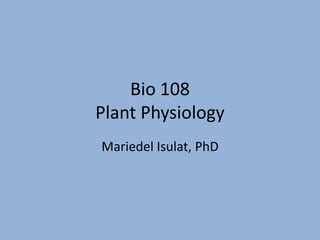
Plant physio
- 1. Bio 108 Plant Physiology Mariedel Isulat, PhD
- 2. Course Outline I. Introduction Overview of Plant Structure Plant Cells II. Transport and Translocation of Water and Solutes Water and Plant Cells Water Balance of the Plant Mineral Nutrition Solute Transport III. Biochemistry and Metabolism Photosynthesis : The Light Reactions Photosynthesis : The Carbon Reactions Photosynthesis : Physiological and Ecological Considerations Translocation in the Phloem Respiration and Lipid Metabolism Assimilation of Mineral Nutrients Secondary Metabolites and Plant Defense
- 3. IV. Growth and Development Gene Expression and Signal Transduction Cell Walls : Structure, Biogenesis and Expansion Growth and Development Phytochrome and Light Control of Development Blue-lIght Responses : Stomatal Movement and Morphogenesis Auxin : The Growth Hormone Gibberelins : Regulators of Plant Height Cytokinins : Regulators of Cell Division Ethylene : The Gaseous Hormone Abscisic Acid : A Seed Maturation and Anti-stress Signal The Control of Flowering Stress Physiology C
- 4. Major Design Elements of Plants 1. Ultimate solar collectors 2. Non-motile but move towards essential resources 3. Structurally reinforced to support their mass 4. Continuously lose water by evaporation but have mechanisms to avoid dessication 5. Have mechanisms for moving water , minerals and photosynthetic products
- 7. Categories of Plants Gymnosperms -less advanced; pine, fir, spruces, redwood ( 700 known species)
- 8. Angiosperms -more advanced, about 250,000 known species
- 9. Plant Structure 1. Plant Cells are sorrounded by cell walls. middle lamella – cement primary and secondary cell walls 2. New cells are produced by meristem apical meristem – tips and axillary buds pericycle – where lateral roots arise primary growth – from apical meristem secondary growth – from lateral meristem vascular cambium –gives rise to secondary xylem and phloem cork cambium – produces the periderm made up of cork cells 3. There are three major tissue systems in plants : Dermal, Ground, Vascular
- 10. Cell Walls Components : cellulose pectin- resist compression glycan – tensile strength Primary cell wall – growing and dividing cells - provide mechanical strength and allows growth and development Secondary Cell Wall – much thicker, deposited after cells ceased to grow
- 14. Fluid-mossaic Model : Cell Membrane
- 16. Chapter 1: Plant Cells Guide Questions Features of Flowering plants: 1. Algae to Ferns : water independence Dessication resistance 2. Vascular tissues 3. Seeds for reproduction ( with endosperm) 4. Flowers ( petals, ovary) innovative dispersal of gametes and progeny
- 17. Roots Regions of a Root: 1. Root cap - protect the apical meristem and to penetrate the soil 2. Apical meristem - the growth region of the root lower side- produces new root cap upper side- produces new growth cells for root growth 3. Elongation region – region for increase in the length of the root 4. Root hair region – where many epidermal cells develop lateral protrusions called root hairs which serve to increase surface area for better absorption 5. Mature region - the region where cork begins to replace epidermal cells ; has reduced ability to absorb water and minerals
- 19. Stems Features : 1. Nodes - the points on a stem where a leaf or leaves are attached 2. Internodes - intervals between the nodes Although the root and stem share many common structural features, the root bears no appendages comparable to leaves, and consequently, has no nodes or internodes.
- 20. Types of root systems: 1. Tap Root System - Smaller roots are organized around a large central root 2. Fibrous Root System - A mass of small adventitious roots as large as the primary root.
- 21. Types of roots: 1. Primary - The primary, or seed root, is the first root formed by a sprouting seed. 2. Adventitious - Roots originating from something other than root tissue, such as the lower portion of the stem. Aerial - Adventitious roots developing above ground with specialized functions such as the climbing or hold-fast roots of some vines.
- 22. Three main stem types: 1. Herbaceous stems - have very little woody tissue - with a single-layered epidermis which secretes a waxy cuticle onto its outer wall. - live for different lengths of time: 2. Woody stems - have a high percentage of woody tissue. wood of a tree - the xylem portion of the stem, as it becomes more massive by further secondary growth, bark – tissues outside the wood and the cambial layer 3. Shrub has several woody stems growing from a single base.
- 23. Tissues of a root: • Vascular tissues: Xylem - water-conducting tissue, wood Phloem - food-conducting tissue, bark. • Endodermis - the inner layer of the cortex. This selectively permeable layer filters absorbed soil water passing into the cells to the xylem. • Cortex - serves as an area for food storage. • Epidermis - a single layer of fatty cells serving to protect the cells beneath.
- 24. Monocot stems have numerous vascular bundles scattered throughout the stem. xylem- located in the half of the bundle toward the center of the stem phloem - occurs in the half toward the outside surface of the stem. Each bundle is surrounded by a sheath of elongated, heavy- walled sclerenchyma fiber cells, which provide mechanical support for the stem. Dicot stems have vascular bundles arranged in the form of a cylinder, around a central core of parenchyma tissue called the pith. The tissue outside the vascular bundles is called the cortex. The outer edge of the cortex, just beneath the epidermis, functions mainly in the mechanical support of the stem.